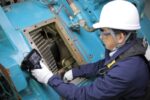Tesla CEO drops bombshell with $72B buyout proposal
Tesla CEO Elon Musk is gearing up to lead a buyout of the electric car maker in a stunning move that would end the maverick company’s eight-year history trading on the stock market. In his typically unorthodox fashion, the eccentric Musk dropped his bombshell on his Twitter account, which he has used as a platform for pranks, vitriol and now for a proposal to pull off one of the biggest buyouts in U.S. history. Musk got the ball rolling Tuesday after the stock market had already been open more than three hours with a tweet announcing he had secured funding to buy all of Tesla’s stock at $420 per share with no further details. At that price, the buyout would cost nearly $72 billion, based on Tesla’s outstanding stock as of July 27, but it’s unlikely the deal would cost that much because Musk owns a roughly 20 percent stake in the Palo Alto, California, company. He also said he intends to give Tesla’s existing shareholders the option of retaining a stake in the company through a special fund, if they want. “Am considering taking Tesla private at $420. Funding secured,” Musk wrote in his first tweet, following up with “good morning” and a smiley emoji. He later tweeted that the only uncertainty about completing the deal is whether he can gain shareholder approval. The first tweet came hours after the Financial Times reported that Saudi Arabia’s sovereign wealth fund had built a significant stake in Tesla Inc., but it was unclear if that was the funding Musk was referring to. The Financial Times, citing unnamed people with direct knowledge of the matter said Saudi Arabia’s Public Investment Fund had built a stake of between 3 and 5 percent of Telsa’s shares. Musk’s announcement was initially met with widespread skepticism, with many people connecting […]









